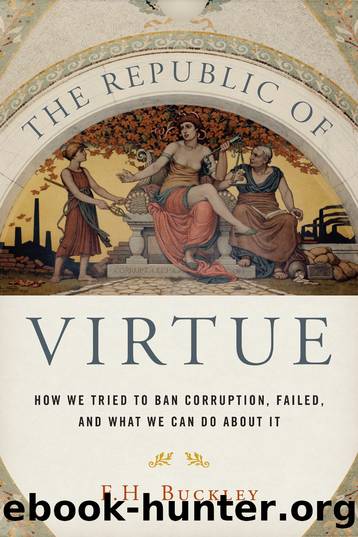The Republic of Virtue: How We Tried to Ban Corruption, Failed, and What We Can Do About It by F. H. Buckley

Author:F. H. Buckley [Buckley, F. H.]
Language: eng
Format: epub
Tags: Political Advocacy, Constitutional, Constitutions, Campaigns & Elections, Political Science, Political Process, Law, Corruption & Misconduct
ISBN: 9781594039713
Google: SDCdDgAAQBAJ
Goodreads: 35873063
Publisher: Encounter Books
Published: 2017-11-28T00:00:00+00:00
â 12 â
The Silver Bullet
LETâS ASSUME that we would do better with a less plaintiff-friendly set of civil justice rules. That doesnât get us very far if we canât agree on what needs fixing. Cases that might appear to be egregious examples of a litigation-mad culture may look different on closer analysis. A classic example is the notorious McDonaldâs hot coffee lawsuit from twenty-five years ago.
In 1992, a seventy-nine-year-old woman ordered a cup of coffee at a McDonaldâs drive-through in Albuquerque. She placed the coffee between her legs. It spilled, burning her severely. She sued McDonaldâs, and a jury awarded her $160,000 for her injury and $2.7 million in punitive damages. Outrageous, right? Well, not so fast. For one thing, she wasnât driving when the coffee spilled. She was holding the cup between her knees and had removed the lid to add cream and sugar when it tipped over. The coffee caused third-degree burns, requiring skin grafts. She offered to settle for $90,000, but McDonaldâs never offered more than $800. The jury was told that McDonaldâs served coffee at 180 or 190 degrees; that a liquid at this temperature would cause third-degree burns; and that this fact was well known to McDonaldâs. Also, the trial judge reduced the final award to $640,000.
So a case that became a poster child for a broken legal system doesnât seem quite so outrageous after all. We may disagree on the merits of this or another court decision, but reasonable people can still agree on the need to restore the Framersâ vision of a judicial system that promotes a race to the top among states, while discouraging a race to the bottom.
The Way Back
The first principle for restoring integrity to our judicial system is that states should be permitted to compete with each other in the judge-made rules they offer in-state parties, but prevented from imposing unfair costs on out-of-state defendants. To do this, only one simple reform is needed: Whenever an in-state plaintiff sues an out-of-state defendant for a nontrivial amount, the latter should be given the option of removing the case to federal court. In other words, we should return to the pre-Strawbridge world of minimal diversity, where a plaintiffâs lawyer canât bar the door to the federal courthouse by strategically joining an in-state party as a defendant.
To make this happen, all that is necessary is a legislative end run around Strawbridgeâs complete diversity requirement. And that would work because, in Strawbridge, Chief Justice Marshall was interpreting the 1789 Judiciary Act and not the Constitution. If Congress thinks that minimal diversity makes more sense, itâs free to adopt that standard, which is precisely what Congress tried to do in the 2005 Class Action Fairness Act (CAFA).1 In two respects, however, CAFA failed to reflect the Framersâ vision of a corruption-free justice system. First, it spoke only to class or mass actions brought on behalf of a group of plaintiffs, and not to cases such as OâKeefe v. Loewen in which a single in-state plaintiff sues an out-of-state defendant and then invokes the complete diversity requirement.
Download
This site does not store any files on its server. We only index and link to content provided by other sites. Please contact the content providers to delete copyright contents if any and email us, we'll remove relevant links or contents immediately.
Killers of the Flower Moon by David Grann(3228)
Machine Learning at Scale with H2O by Gregory Keys | David Whiting(2267)
Will by Will Smith(2033)
Guns, Germs and Steel by Diamond Jared(1876)
Borders by unknow(1779)
The Room Where It Happened by John Bolton;(1717)
The Color of Law by Richard Rothstein(1574)
Once Upon a Broken Heart by Stephanie Garber(1472)
Water Rights and the Environment in the United States by John Burch(1413)
Examples & Explanations: Administrative Law by William F. Funk & Richard H. Seamon(1324)
Friends, Lovers, and the Big Terrible Thing by Matthew Perry(1324)
A Short History of War by Jeremy Black(1295)
Pharmacy Practice and The Law by Richard Abood(1252)
HBR's 10 Must Reads 2022 by Harvard Business Review(1251)
That Every Man Be Armed by Stephen P. Halbrook(1236)
The Strength In Our Scars by Bianca Sparacino(1234)
The Guarded Gate by Daniel Okrent(1218)
515945210 by Unknown(1205)
Injustices by Ian Millhiser(1196)
